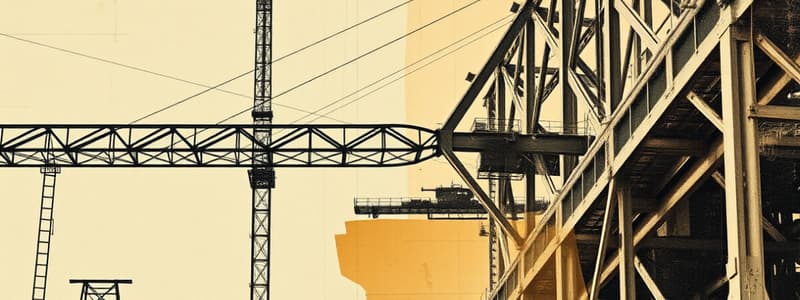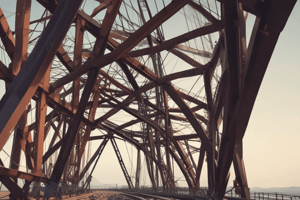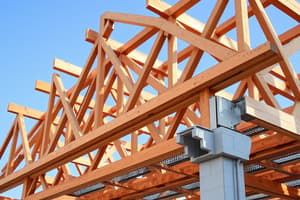Podcast
Questions and Answers
Match the following structural elements with their definitions:
Match the following structural elements with their definitions:
Torsion = A force tending to twist a structural member Transfer beam = A beam that carries a load around large openings Ultimate strength = The highest load a member can sustain before failure Wall = A structural element that transmits compressive forces to the ground
Match the following types of trusses or beams with their characteristics:
Match the following types of trusses or beams with their characteristics:
Triangular truss = A roof truss that is triangular in shape Vierendeel truss = A rectangular truss with rigid corner bracing Truss = A framed structure consisting of triangles Web = The group of struts, ties, and panel points in a truss
Match the following construction terms with their descriptions:
Match the following construction terms with their descriptions:
Veneer wall = A wall designed to improve exterior appearance Tube construction = Externally braced structure Weep holes = Drainage holes in a masonry wall Wet joint = Cast-in-place concrete uniting rods from precast sections
Match the following load types with their definitions:
Match the following load types with their definitions:
Match the following masonry terms with their meanings:
Match the following masonry terms with their meanings:
Match the related terms from structural engineering:
Match the related terms from structural engineering:
Match the following elements of construction with their primary purpose:
Match the following elements of construction with their primary purpose:
Match the following engineering concepts with their applications:
Match the following engineering concepts with their applications:
Flashcards are hidden until you start studying
Study Notes
Structural Elements and Forces
- Torsion: A force that creates a twisting effect on structural members, leading to potential material stress.
- Transfer Beam: Engineered to carry loads around large openings or areas, minimizing the need for columns in intervening spaces.
- Transmission: Refers to the distribution mechanism of loads from their application point to the ground.
Trusses and Structural Design
- Triangular Truss: A triangular-shaped roof truss utilized for creating peaked roofs, providing stability through its geometric configuration.
- Truss: A framed construction utilizing triangles to ensure that loads only induce direct stresses (tension or compression) at the member intersections.
- Vierendeel Truss: Distinguished by its rectangular shape and rigid corner bracing, designed for enhanced stability and load distribution.
Material and Wall Structures
- Veneer Wall: A façade consisting of a thin, single thickness of masonry that enhances aesthetic appeal while being structurally complementary.
- Wall Column: A supporting structural element made of steel, reinforced concrete, or solid masonry, directly receiving concentrated loads from above.
- Wythes: Continuous vertical walls constructed with a single thickness of masonry units, contributing to structural integrity.
Load Considerations and Strengths
- Ultimate Strength: Represents the maximum load a structural member can withstand before failing, crucial for design safety.
- Uniformly Distributed Load: A load that is evenly spread across a defined area, affecting structures evenly and simplifying load analysis.
Additional Structural Features
- Web: The internal system of struts, ties, and panel points within trusses that provides structural support and stability.
- Weep Holes: Drainage features in masonry walls that enable trapped water to escape, preventing moisture-related damage.
- Wet Joint: A concrete joint that connects rods from precast segments, enhancing integrity in cast-in-place construction.
Environmental and Safety Factors
- Wind Load: The forces exerted by wind on structures, which can be positive or negative, requiring careful consideration in design.
- Watts (W): A unit that measures the energy release rate of a fire, essential for assessing fire safety in structural design.
Studying That Suits You
Use AI to generate personalized quizzes and flashcards to suit your learning preferences.





